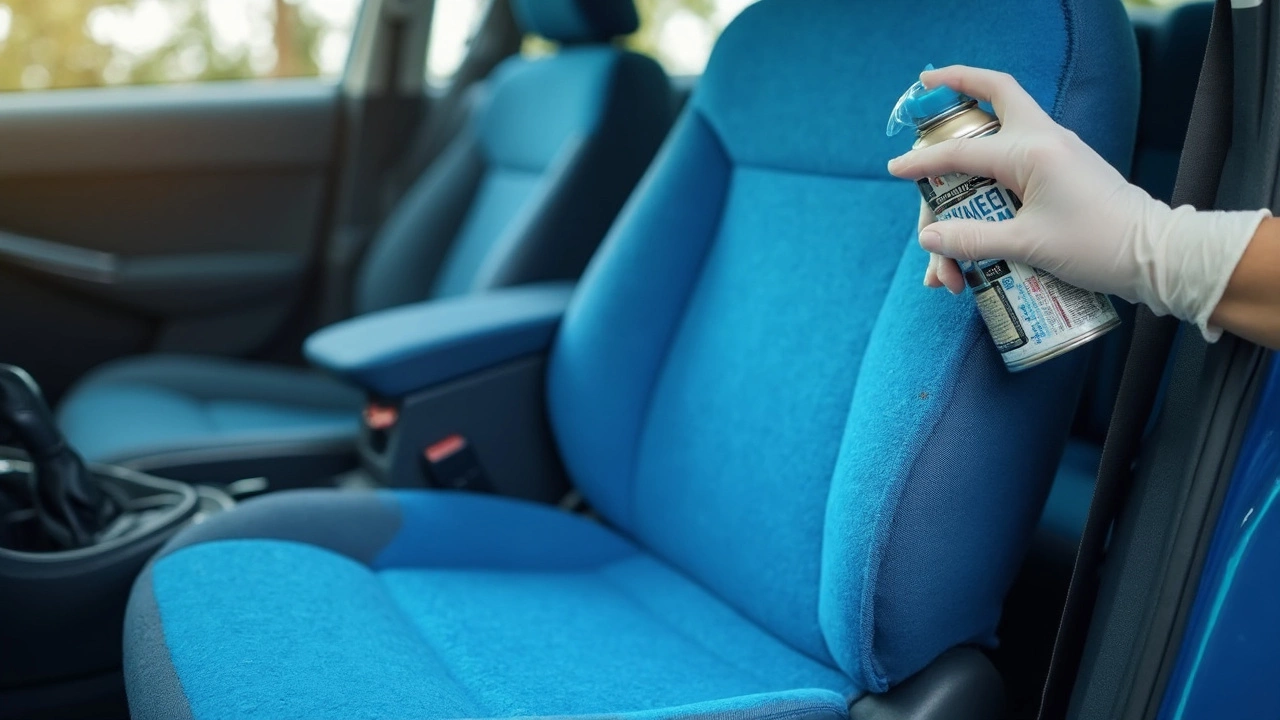Can You Paint Car Interior Fabric? Practical Tips and Real Talk
 Jun, 21 2025
Jun, 21 2025
Spilled coffee, faded seats, or just sick of that ugly beige? You’re probably wondering if you can actually paint your car’s fabric and make it look decent. Most people think car upholstery is impossible to change without spending big bucks at an upholstery shop. But here’s the thing—not only can you paint car interior fabric, it’s actually a pretty popular DIY move. You just need the right tools and some patience.
Professionals and hobbyists have been using fabric paints and dyes to totally refresh car seats, door cards, and even headliners. Not everything on the market works, though. Skip the regular spray paint, unless you want your seats to feel like cardboard. There are sprays and dyes made specifically for car interiors. These let the fabric stay flexible and can really change the color without making it crackly or stiff.
If you’ve got stubborn stains, faded fabric, or just want a bold change—painting is a surprisingly effective way to do it. But there’s a trick to making sure the result looks clean and lasts more than a couple of months. It all comes down to prep work and the products you pick. People get the best results on seats and panels that are just a little worn out, not ripped or threadbare.
- Is Painting Car Fabric Even Possible?
- Choosing the Right Paint and Tools
- Step-by-Step: How to Paint Car Interior Fabric
- Real-World Results and Mistakes to Avoid
Is Painting Car Fabric Even Possible?
Yeah, it’s actually possible to paint car interior fabric and get solid results. It’s not just something you see in car forums—there are folks out there driving around with DIY-painted seats that hold up for years. The idea might sound weird at first, but when you think about all the fabric dyes used in clothes and furniture, it starts making sense.
First thing you need to know: you have to use products made specifically for automotive interiors. The stuff you buy for T-shirts or canvas art just doesn’t cut it. Companies like Dupli-Color, SEM, and ColorBond make special spray dyes and paints that soak into fabric without sealing it up like glue. This is key, because if you use regular spray paint, your seat’s gonna end up crunchy and gross.
The process is pretty common for older cars where replacing upholstery is pricey or impossible. You’ll see classic car owners and budget customizers painting their faded seats instead of re-covering them, just to squeeze a few more years of fresh style out of their ride.
| Fabric Area | Painted? | Typical Longevity (Years) | Feels Normal? |
|---|---|---|---|
| Seat Cloth | Yes | 2-4 | Mostly |
| Carpet | Yes | 2-3 | Yes |
| Headliner | Possible, tricky | 1-2 | Can stiffen |
| Door Panels (fabric) | Yes | 2-5 | Yes |
The main reason painting works is because these automotive fabric sprays are more like dyes than ordinary paint. They actually absorb into the fabric instead of just sitting on top. That means your seats and panels feel pretty much the same after painting, not weirdly slippery or hard.
One cool thing: upholstery shops sometimes use the very same products in pro restorations, especially when exact fabric matches aren’t available. So if you follow the right steps, your DIY job can look borderline factory. The catch? Heavily stained or torn fabric won’t magically look brand new—paint only covers color, not major damage.
For anyone thinking about this project, it’s not risky for most fabrics, but make sure you test on a hidden spot first. Some ultra-cheap materials or stuff with fancy coatings just won’t play nice with paint or dye.
So, the answer is yes—painting car interior fabric is absolutely possible, and you might be surprised how legit the result can look if you’re careful with your prep and materials.
Choosing the Right Paint and Tools
If you’re serious about fixing up car seats or door panels, choosing the right products matters way more than you think. Not every can of paint is the same. Those cheap craft paints and basic hardware-store spray paints? Skip them. They’ll peel, fade, and make your car’s fabric feel like plastic. That said, a few specific types of products consistently get good results.
The number one thing you want is fabric spray paint or upholstery dye designed for car interiors. Popular options include SEM Color Coat, Dupli-Color Vinyl & Fabric Spray, and VHT Vinyl Dye. These are made to sink into fabric fibers and hold up to everyday abuse, which means the color won’t rub off even if you’re wearing jeans loaded with metal on the pockets. These products leave seats feeling soft—not weird and crusty.
Here’s a quick breakdown of what you’ll need:
- Paint car interior fabric products: Look for “fabric” or “upholstery” on the label.
- A spray handle attachment: Makes spraying more even, so you don’t get streaks.
- Drop cloths or old sheets: Keeps that expensive paint off your dashboard and carpet.
- Masking tape: Great for protecting seat belts, buttons, or headrest posts.
- Scrub brush and vacuum: For cleaning before you paint. Dirt ruins the finish.
- Latex gloves and a mask: Paint (even the good stuff) is messy and smells strong.
Let’s get specific. Check out this comparison table so you can see what separates decent products from the duds:
| Product Name | Type | Works On | Cost Per Can | Color Choices | Soft Feel? |
|---|---|---|---|---|---|
| SEM Color Coat | Flexible Coating | Fabric, Vinyl | $18–$22 | Dozens | Yes |
| Dupli-Color Vinyl & Fabric | Aerosol Dye | Fabric, Vinyl | $10–$12 | 9 | Yes |
| VHT Vinyl Dye | Color Spray | Vinyl, Some Fabrics | $8–$10 | 8 | Mostly |
| General Spray Paint | Standard Spray | Hard Surfaces | $5–$8 | Many | No |
Most car seats take about 2–3 cans for a full color change. Try to buy an extra can, just in case. And always test your chosen product on a hidden spot first. Sometimes colors react weirdly depending on what’s already in your upholstery.

Step-by-Step: How to Paint Car Interior Fabric
Ready to jump in? Here’s a practical guide to painting your car’s fabric. You don’t need pro tools or a crazy budget—just the right prep, patience, and focus. First rule? Don’t rush. Nothing ruins a fresh interior faster than skipping steps.
Here’s exactly what you need before you even shake that spray bottle:
- Automotive fabric spray paint or upholstery dye (brands like Dupli-Color or SEM Color Coat work well)
- Masking tape and plastic sheets (to protect glass, trim, and anything you don’t want to hit with paint)
- Stiff brush or vacuum
- Mild soap, warm water, and clean cloths
- Nitrile gloves
The play-by-play for a clean, long-lasting job looks like this:
- Deep Clean the Fabric. Dirt and oils can ruin the look. Go at it with a vacuum and brush, then scrub using mild soap and water. Let it dry fully before painting—slap a fan on it if you’re impatient.
- Protect Everything Else. Cover windows, trim, and panels you’re not painting. Masking is boring, but you’ll regret skipping it if you end up with purple seatbelts.
- Shake and Test. Shake your spray paint for a solid two minutes. Test a little spray on a scrap or hidden area to make sure you like the shade and finish.
- Light Coats Are Everything. Spray lightly, holding the can about 8 inches from the surface. Heavy coats will soak the fabric and might crack later. Let each coat dry (usually 10-20 minutes) before going over it again.
- Repeat as Needed. Two to four coats usually does the trick. More for lighter coverage, fewer for dark fabrics. Don’t panic if it looks patchy at first—it evens out.
- Let It Cure. Give it at least 24 hours before you sit on it. If you’re painting in a humid garage, 48 hours is safer.
It’s not just about looks—proper curing keeps the color from rubbing off onto your clothes. Here’s a quick breakdown of what you get if you follow these steps, based on common fabric paint brands:
| Paint Brand | Coverage Per Can (sq. ft.) | Dry Time (per coat) | Fully Cured | Average Cost (USD) |
|---|---|---|---|---|
| Dupli-Color Vinyl & Fabric | 16-18 | 8-10 min | 24 hrs | $10-12 |
| SEM Color Coat | 12-14 | 5-10 min | 24 hrs | $14-18 |
| Rust-Oleum Fabric & Vinyl | 12-15 | 10 min | 24-48 hrs | $8-10 |
One more thing: Test the color under real car lighting. Sunlight can mess with how your new shade looks compared to garage light. A small patch test will save you from ‘surprise blue’ when you hit the road. If you want your project to pop, the paint car interior fabric method is hard to beat—when you do it right.
Real-World Results and Mistakes to Avoid
People who try painting their car interior fabric get pretty mixed results. Some are blown away by how brand new the seats look, while others regret even starting. If you do your research and use the right stuff, like dedicated paint car interior fabric spray or dye, you’ll probably end up in the first group.
One thing that helps is doing a small test patch first—some synthetic fabrics take color differently. And those deep stains from years ago? They might still show through after painting if you skip good cleaning and prep. Even high-quality fabric paint won’t hide grime.
Here’s where most folks mess up and how you can avoid their headaches:
- Skipping the vacuum and deep clean. Paint sticks best to spotless fabric. Use a carpet cleaner or upholstery cleaner, not just a wipe-down.
- Not taping off surrounding areas. If you don’t mask plastic trim and seatbelts, overspray will be nearly impossible to get off.
- Heavy coats. Laying the paint on thick is a huge mistake. It’ll make your seats crusty and uneven. Several light coats give a far better, softer finish.
- Using the wrong product. Regular hardware store spray paint is meant for metal and plastic, not seats. Stick with paints or dyes made for automotive or upholstery use.
- Not letting it fully dry. If you sit down too soon, you’ll leave weird marks—or worse, transfer dye to your clothes.
Some colors cover better than others. Dark colors on light fabric look solid after just a few coats, but going light over dark is rarely successful. Also, heavy sun exposure over months can cause fading, especially if you skipped UV-resistant paint. Don’t expect the seats to feel exactly like factory fabric—they’ll usually be a tiny bit stiffer, but a lot of people are fine with the trade-off for a fresh interior.
Real talk—if you rush, cut corners, or pick the wrong product, it’s going to show. Spend extra time on prep, and think about your daily use. Got kids or pets? Expect more touch-ups. But when it’s done right, friends are usually shocked to learn you didn’t spend a fortune at the upholstery shop.